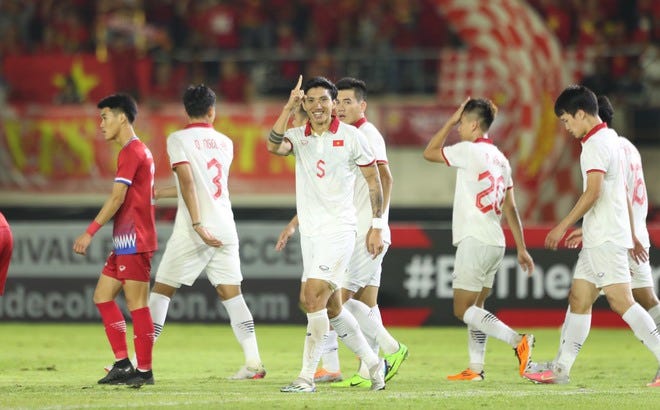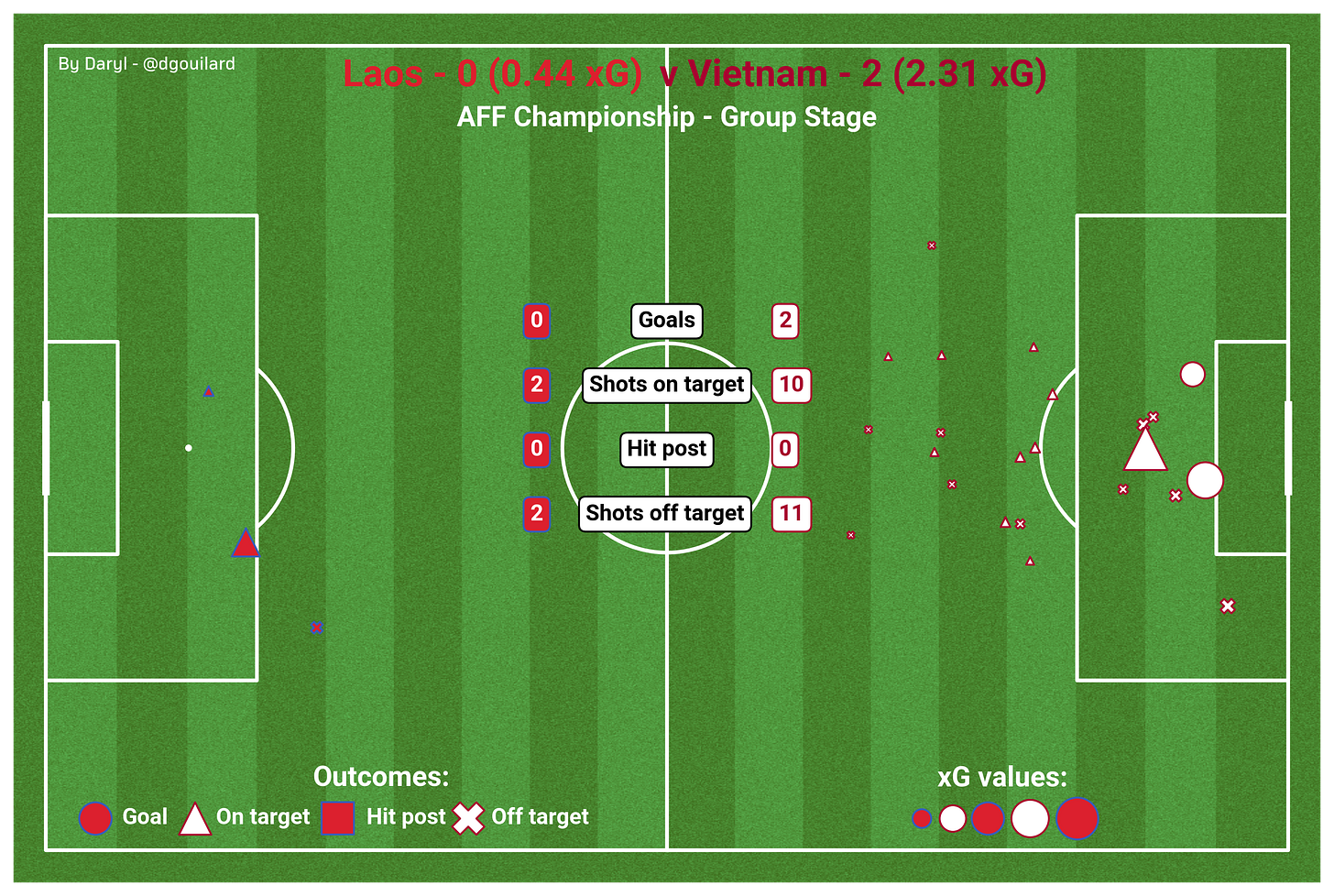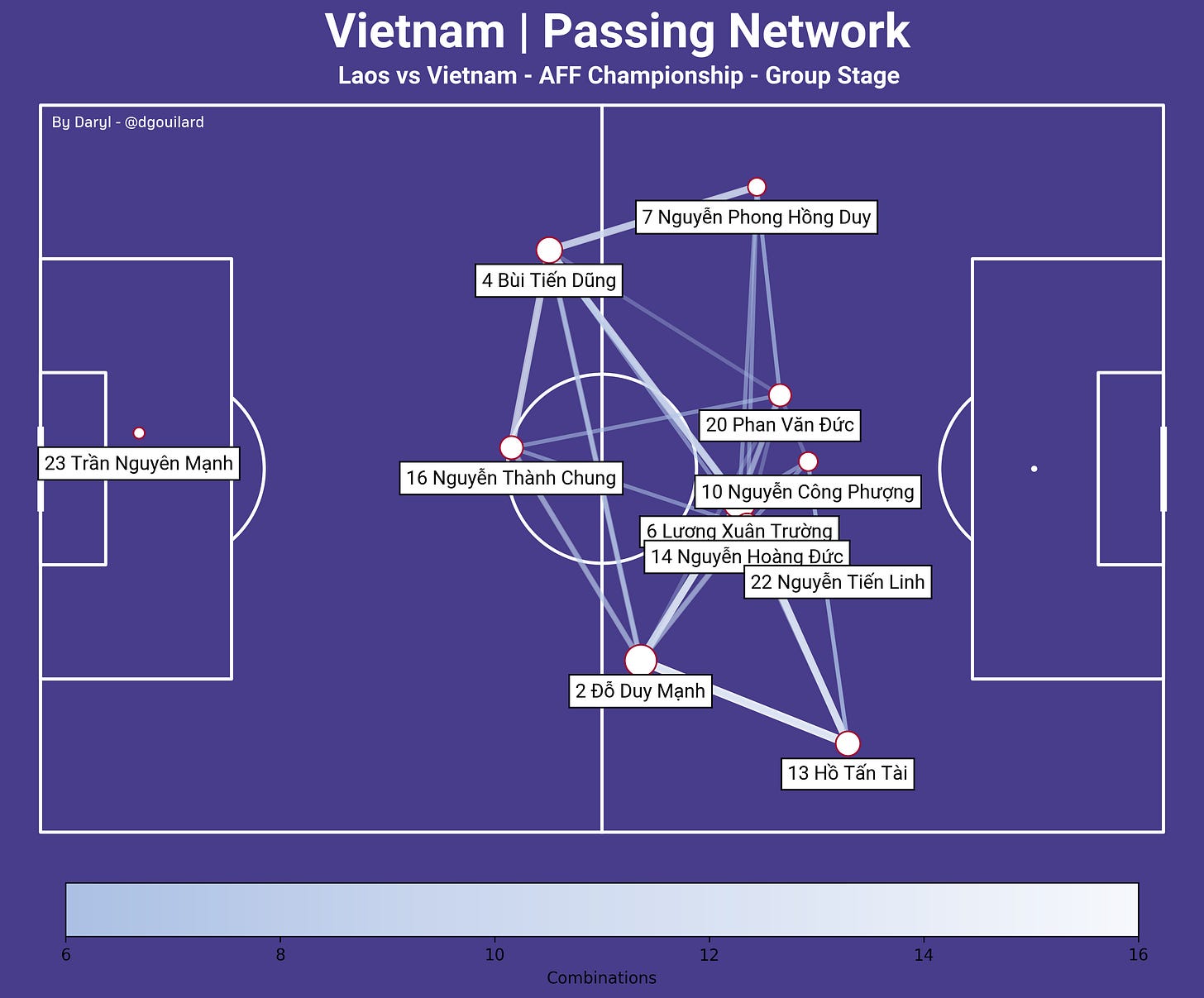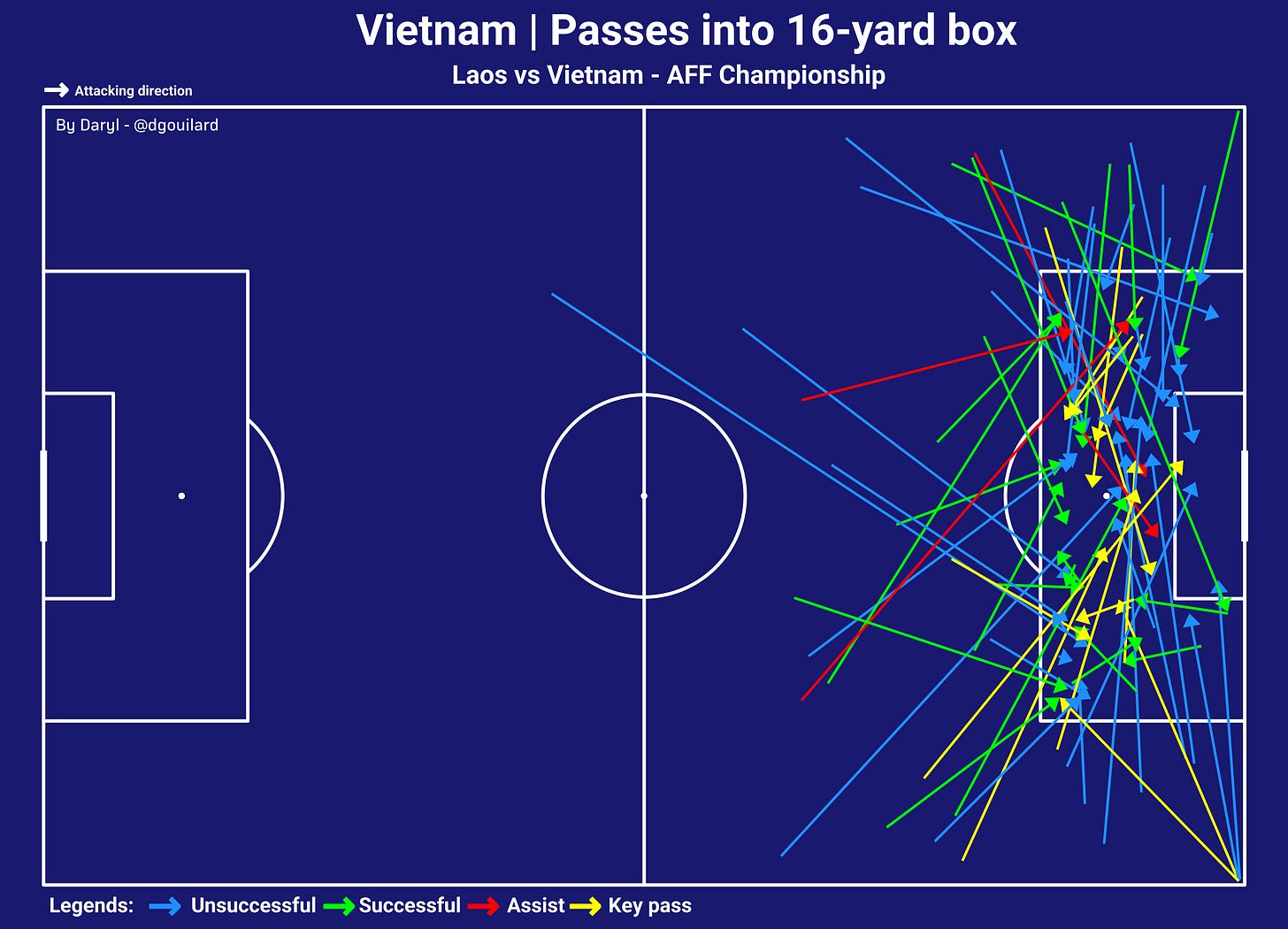Through the lens of data - AFF Cup 2022: Laos vs Vietnam
Using data visualisations, what can we see from Vietnam's comfortable 6-0 win against Laos in their opening match of the AFF Cup?
While the scenes of Lionel Messi and Argentina celebrating their World Cup triumph lives on in the memory of millions, if not billions, of fans after the 2022 edition is wrapped up, the festival of football is not ended, at least for millions of Southeast Asian fans. The 2022 AFF Cup started just merely two days after the World Cup allows every football fans in the SEA region to continue to be treated with excitement while cheering on for their nation in what is considered to be one of the most important tournaments of the region.
Last night, Vietnam started their journey to regain their throne against a Laos side that were predicted to cause little to no troubles for one of the tournament’s favourites. And to no one’s surprise, Park Hang-seo’s side came out on top with an easy and comfortable 6-0 win. Using data visualisations, what can we conclude from Vietnam’s outstanding tournament-opener?
An improvement in chance creation
Interestingly, Laos and Vietnam also faced each other at the AFF Cup group stage just over a year ago in a delayed edition due to Covid-19. While the away side also secured a win back then, many were quick to criticise how Vietnam could have shown a better performance. Those criticisms were not wrong, especially given that Vietnam were competing in the third round of the Asian Qualifiers at the same time and faced opponents who were way stronger than them and still managed to show a decent performance against Australia or Saudi Arabia.
Vietnam came out of the 2021 encounter with only 2.31 xG while scoring two goals, which suggests that while they did manage to create plenty of chances, most of those chances were not very dangerous towards Laos’ goal. They struggled to break down a well-structured low block from the opposition and were forced to make plenty of long shots from outside of the 16-yard box, which resulted in low-quality chances. The two goals that they scored were from inside of the penalty box and they were the closest attempts to Laos’ goal.
Over a year on from that match and Vietnam showed a significant improvement in their chance creation process. This time around, they managed to create most of their goal-scoring chances inside of the 16-yard box and were significantly more threatening to the opposition. Even though a few of their chances were off target or blocked, it still showed the determination to get the ball into the box from the Vietnamese players rather than being impatient and rely on long shots to approach the opposition’s goal.
The xG timeline from last night’s match showed a slightly different story compared to the timeline from the match in 2021. In both matches, Vietnam were slowed to approach the match and they needed a decent amount of time in the first half to find the opening goal. They approached the 1 xG mark close to half time, and after coming back from the break, they never looked back. Only this time, once they started to get the hang of the match through Tấn Tài and Văn Hậu’s goals, Vietnam went on to create more dangerous chances (partly because Laos also started to push forward a bit more) and finished the match with two more goals from Văn Toàn and Văn Thanh.
The Hanoi effect
While Vietnam’s formation did not go through any significant changes, what Park has for this tournament in comparison to the “2020” tournament was the return of several key players from Hanoi FC, namely left wing-back Đoàn Văn Hậu, central midfielder Đỗ Hùng Dũng, and attacking midfielder Nguyễn Văn Quyết. All three were involved in Vietnam’s 6-0 win against Laos, with Văn Hậu and Hùng Dũng starting the match and Văn Quyết came off the bench for an injured Nguyễn Quang Hải.
In the match between both teams in 2021, Hồng Duy and Xuân Trường started in the positions that would later belong to Văn Hậu and Hùng Dũng. At left wing-back, Hồng Duy did not offer plenty offensively as most of the team’s attacks were down Tấn Tài’s right-hand side. Hồng Duy was not creative when making crosses either as he preferred to take the ball close to the byline and simply lofted the ball into the 6-yard box or the far post.
Meanwhile, in the central area of the pitch, Vietnam had Xuân Trường and Hoàng Đức, two players who preferred to dictate the play and distribute the ball. Because both players were focused on playmaking, they offered little to no offensive threat inside the final third and penalty box. This left the attacking trio of Văn Đức, Công Phượng, and Tiến Linh to finish the attacks all by themselves.
This time, however, the inclusion of Hùng Dũng allowed Hoàng Đức to stay slightly deeper and take on the playmaking responsibility for the team while Hùng Dũng was more offensive and offered more inside the final third. Văn Hậu returning to the left-hand side also gave Vietnam another attacking outlet besides Tấn Tài on the right wing since Văn Hậu excels when playing as a left wing-back.
So what exactly did Văn Hậu offer when he returned to the starting lineup? Laos were expected to sit deep and absorb the pressure from Vietnam and they did just that, which left Vietnam with three options to break down Laos’ low-block, going through, going over, or going around the low-block. In the majority of this match, they opted to go around the low-block and relied on crosses from both flanks to get the ball into the box, which they succeeded in doing so on multiple occasions. In total, Vietnam had 13 key passes and 38 successful passes into the penalty box, which highlight their emphasis on attacking down both wings.
With Văn Hậu alone, he made 8 passes into the 16-yard box from left wing, including one assist that led to Tiến Linh’s opening goal. Interestingly, rather than aimlessly dribbled the ball close to the byline and lofted the ball into the box, Văn Hậu tried to make multiple low, early crosses into the box to encourage Tiến Linh and Văn Đức to attack the channel and receive the ball in a good goal-scoring position. This is the major difference between Văn Hậu and Hồng Duy as Hanoi’s wing-back showed more creativity when he has the ball, the crucial aspect that Vietnam desperately needed in the previous tournament to break down low-blocks.
As mentioned, the return of Hùng Dũng was very crucial for Vietnam as he can be considered as the heart of Vietnam’s midfield. The Hanoi midfielder was everywhere in this match, from dropping deep to receive the ball and make forward passes, to drifting wide to provide support for the wing-backs. He was a dynamic midfielder that linked the midfield and the wing-backs to the strikers, a type of midfielder that Vietnam were also looking for in previous tournaments.
What’s next for Vietnam?
Coming off the back of a valuable Asian Qualifiers experience and an underperformed “2020” AFF Cup, it is clear that Vietnam have improved, and improved significantly, to give the fans an outstanding performance as the tournament-opener. This is also Park Hang-seo’s last tournament with the national team, which will boost the players’ determination to win this AFF Cup as a farewell gift for Park.
Malaysia will be Vietnam’s next opponent and they will be one of the two teams that should give Vietnam a proper fight. The last time both teams faced in the AFF Cup, which was also in 2021, Malaysia went out with a very well-organised low-block that frustrated Vietnam and forced them to finish second in their group. However, Malaysia’s performance against Myanmar should give Vietnam confidence that if they can perform at their very best, they can secure another win to solidify their top spot and avoid an “Agueroooooo!!!!” situation.











